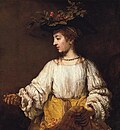Top Qs
Timeline
Chat
Perspective
Flora (mythology)
Roman flower goddess From Wikipedia, the free encyclopedia
Remove ads
Flora (Latin: Flōra) is a Roman goddess of flowers and spring.[1] She was one of the twelve deities of traditional Roman religion who had their own flamen, the Floralis, one of the flamines minores. Her association with spring gave her particular importance at the coming of springtime, as did her role as goddess of youth.[2] She is one of several fertility goddesses and a relatively minor figure in Roman mythology. Her Greek counterpart is Chloris.

Remove ads
Etymology
The name Flōra descends from Proto-Italic *flōsā ('goddess of flowers'), itself a derivation from Proto-Italic *flōs ('flower'; cf. Latin flōs, flōris 'blossom, flower').[3] It is cognate with the Oscan goddess of flowers Fluusa, demonstrating that the cult was known more widely among Italic peoples. The name ultimately derives from Proto-Indo-European *bʰleh₃ōs ('blossoming').[3]
Festivals and temples
Flora's festival, the Floralia, was held between April 28 and May 3 and was celebrated with drinking, flowers, and entertainments (ludi).[4] The festival was first instituted in 240 BCE, and on the advice of the Sibylline books, she was also given a temple in 238 BCE. At the festival, with the men decked in flowers, and the women wearing normally forbidden gay costumes, five days of farces and mimes were enacted – ithyphallic,[5] and including nudity when called for[6] – followed by a sixth day of the hunting of goats and hares.[7] On May 23 another flower festival was held, the Rosalia.[4]
Remove ads
Interpretatio graeca
Flora's Greek equivalent is the nymph Chloris,[8] whose myths were assimilated to Flora in mythological narratives (interpretatio graeca). The Hellenized Flora was married to Favonius, the wind god also known as Zephyr, and her companion was Hercules. According to the legend, Flora ran away from Favonius, but he caught her, married her and gave her dominion over the flowers.[9]
In the classical tradition
Music
Flora is the main character of the 1894 ballet The Awakening of Flora.
In painting
- Detail of Flora from Primavera by Botticelli, c. 1482
- Flora by Titian, 1515
- Idealized Portrait of a Courtesan as Flora by Bartolomeo Veneto, c. 1520
- Flora by Francesco Melzi, c. 1520
- Flora and Zephyr, by Jan Brueghel the Elder and Peter Paul Rubens, 1617
- Flora by Claude Vignon, 1650
- Flora by Rembrandt, 1654
- Flora or Hebe by Alexander Roslin, 18th century
- Flora by Valentine Walter Bromley, 1874
- Flora by Ferdinand Keller, 1883
- Flora by Mosè Bianchi, 1890
Sculpture
There are many monuments to Flora, for example in Rome (Italy), Valencia (Spain), and Szczecin (Poland).
- statue of Flora at Orangerie Kassel, around 1703
- Flora Farnese (Naples), mid-18th century AD
- Statue of Flora in Szczecin, Poland, 1730.
Remove ads
See also
References
External links
Wikiwand - on
Seamless Wikipedia browsing. On steroids.
Remove ads















